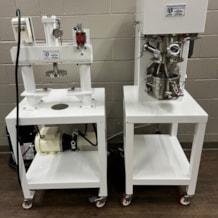
Ross Double Planetary Mixer, model DPM-1QT, stainless steel construction, .75 hp, 1750 rpm, 230/460 volt drive with VFD controller
STANDARD FEATURES:
Full vacuum change can design.
DPM-1QT model: air/oil hydraulic lift raises and
lowers the mix can to and from the mixing position.
Integrated base design for mounting on table top or
work bench.
Rectangular stirrers or High Viscosity “HV” blades
Agitator drive components and lift system are fully
sheathed.
Stainless steel type 304 wetted parts with 80 grit polish.
Non-stainless steel components are finished with a
durable two-part epoxy coating.
TEFC 230/460 volt, 3 phase, 60 Hz motor.
Stainless steel gearbox with Viton sealing o-rings and
lip seals on stirrer shaft. Safety limit switch to prevent operation of the mixer when the mix vessel or agitators are not in the mixing position.

Ross Discharge Press, model DS-1QT, with 0.5 hp, 208-460 volt hydraulic pump
Transfer non-flowable products out of the mix vessel quickly and efficiently.
Any process is only as fast as its slowest operation. ROSS Discharge Systems used with change-can design mixers significantly improve production speed, efficiency, cleanliness and plant safety.
Benefits of Choosing a ROSS Discharge System
What does a ROSS Discharge System do?
A Discharge System eliminates wasted hours of scraping heavy or sticky materials from a mix vessel. With push-button simplicity, the system can automatically discharge several hundred gallons of product in minutes — into bulk containers, filling or packaging equipment, or any downstream process. Yield from every batch is maximized because typically, only a thin layer of product remains on the vessel bottom.
How does a ROSS Discharge System work?
A Discharge System consists of a platen that is lowered hydraulically into a mix vessel. The platen is fitted with an O-ring which rides against the vessel wall. As the platen pushes down on the batch, sidewall surfaces are virtually wiped clean by the O-ring. Product is forced out through a valve on the side or center bottom of the vessel, or through the top of the platen. The platen may be jacketed to maintain batch temperature during discharge.